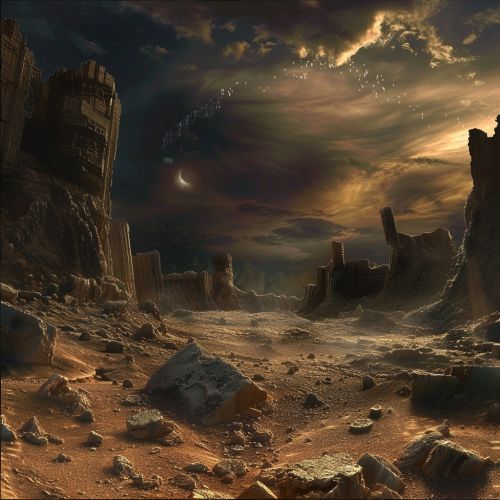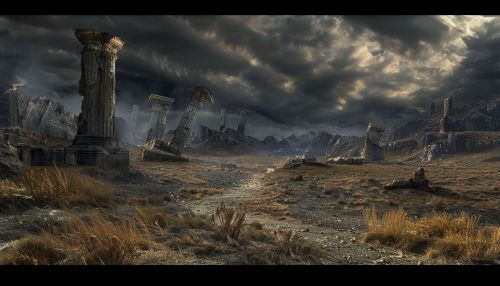The Dying Earth: Difference between revisions
(Created page with "== Introduction == "The Dying Earth" is a term used to describe a subgenre of science fiction and fantasy literature that explores the far future of Earth, typically depicting a world in decline or on the brink of extinction. This genre often combines elements of science fiction and fantasy, presenting a vision of a world where advanced technology and magic coexist, and humanity faces existential threats. The concept has been popularized by various authors, most...") |
No edit summary |
||
| Line 25: | Line 25: | ||
A pervasive sense of melancholy and nostalgia often permeates Dying Earth stories. Characters may reminisce about the lost golden ages of their world, lamenting the decline of their once-great civilizations. This emotional tone adds depth to the narrative and emphasizes the themes of loss and decay. | A pervasive sense of melancholy and nostalgia often permeates Dying Earth stories. Characters may reminisce about the lost golden ages of their world, lamenting the decline of their once-great civilizations. This emotional tone adds depth to the narrative and emphasizes the themes of loss and decay. | ||
[[Image:Detail-96157.jpg|thumb|center|A desolate, decaying landscape with remnants of ancient civilizations and a dark, foreboding sky.|class=only_on_mobile]] | |||
[[Image:Detail-96158.jpg|thumb|center|A desolate, decaying landscape with remnants of ancient civilizations and a dark, foreboding sky.|class=only_on_desktop]] | |||
== Notable Works and Authors == | == Notable Works and Authors == | ||
Latest revision as of 09:21, 4 July 2024
Introduction
"The Dying Earth" is a term used to describe a subgenre of science fiction and fantasy literature that explores the far future of Earth, typically depicting a world in decline or on the brink of extinction. This genre often combines elements of science fiction and fantasy, presenting a vision of a world where advanced technology and magic coexist, and humanity faces existential threats. The concept has been popularized by various authors, most notably Jack Vance, whose "Dying Earth" series has become a seminal work in this genre.
Historical Context
The Dying Earth subgenre can trace its roots back to the early 20th century, with influences from both science fiction and fantasy literature. The genre gained prominence with the publication of Jack Vance's "The Dying Earth" in 1950. Vance's work drew inspiration from earlier writers such as H.G. Wells, William Hope Hodgson, and Clark Ashton Smith, who explored themes of a decaying Earth in their stories.
The genre has since evolved, with contemporary authors like Gene Wolfe, Michael Moorcock, and M. John Harrison contributing their own unique visions of a dying Earth. These works often reflect the anxieties and concerns of their respective eras, such as environmental degradation, technological advancement, and the decline of civilization.
Themes and Motifs
The Dying Earth subgenre is characterized by several recurring themes and motifs:
Entropy and Decay
One of the central themes in Dying Earth literature is the concept of entropy and decay. The stories often depict a world in which natural resources are depleted, ecosystems are collapsing, and civilizations are in decline. This theme serves as a metaphor for the inevitable decline of all things and the transient nature of human achievements.
Advanced Technology and Magic
In many Dying Earth stories, advanced technology and magic coexist, blurring the lines between science fiction and fantasy. This fusion creates a unique setting where ancient, forgotten technologies and powerful magical artifacts can be found alongside each other. The presence of these elements often highlights the contrast between the past's grandeur and the present's decay.
Existential Threats
Dying Earth narratives frequently involve existential threats to humanity, such as environmental disasters, alien invasions, or the resurgence of ancient evils. These threats serve to underscore the fragility of human existence and the precariousness of civilization.
Melancholy and Nostalgia
A pervasive sense of melancholy and nostalgia often permeates Dying Earth stories. Characters may reminisce about the lost golden ages of their world, lamenting the decline of their once-great civilizations. This emotional tone adds depth to the narrative and emphasizes the themes of loss and decay.


Notable Works and Authors
Jack Vance
Jack Vance's "The Dying Earth" series is perhaps the most iconic example of the genre. The series, which includes "The Dying Earth" (1950), "The Eyes of the Overworld" (1966), "Cugel's Saga" (1983), and "Rhialto the Marvellous" (1984), is set in a distant future where the sun is dying, and the remnants of humanity struggle to survive in a world filled with ancient magic and forgotten technologies. Vance's richly detailed world-building and unique prose style have made his work a cornerstone of the genre.
Gene Wolfe
Gene Wolfe's "The Book of the New Sun" (1980-1983) is another seminal work in the Dying Earth subgenre. The series follows the journey of Severian, a torturer who rises to become the ruler of a decaying Earth. Wolfe's intricate narrative structure, complex characters, and philosophical themes have earned the series critical acclaim and a devoted readership.
Michael Moorcock
Michael Moorcock's "Dancers at the End of Time" series (1972-1976) presents a more whimsical and satirical take on the Dying Earth genre. The series is set in a far future where the last remnants of humanity, possessing god-like powers, indulge in hedonistic pursuits while the universe around them slowly decays. Moorcock's work explores themes of decadence, morality, and the nature of existence.
M. John Harrison
M. John Harrison's "Viriconium" series (1971-1984) offers a more fragmented and surreal vision of a dying Earth. The series is set in the city of Viriconium, a decaying metropolis that serves as a microcosm for the larger world. Harrison's work is known for its poetic prose, ambiguous narrative, and exploration of themes such as identity, memory, and the passage of time.
Influence and Legacy
The Dying Earth subgenre has had a significant impact on both science fiction and fantasy literature. Its themes and motifs have been adopted and adapted by numerous authors, influencing works such as Isaac Asimov's "The End of Eternity" (1955), Arthur C. Clarke's "The City and the Stars" (1956), and Philip K. Dick's "Do Androids Dream of Electric Sheep?" (1968).
The genre has also inspired various other media, including films, television series, and role-playing games. For example, the tabletop role-playing game "Dungeons & Dragons" has incorporated elements of the Dying Earth genre into its settings and lore, particularly in the form of the "Dark Sun" campaign setting.
Scientific Perspectives
While the Dying Earth subgenre is primarily a work of fiction, it often draws on real scientific concepts and theories. For example, the idea of a dying sun is based on the scientific understanding of stellar evolution. Stars like our sun will eventually exhaust their nuclear fuel and enter a red giant phase, leading to the eventual demise of any planets orbiting them.
Environmental themes in Dying Earth literature also reflect real-world concerns about climate change, resource depletion, and ecological collapse. These stories serve as cautionary tales, warning of the potential consequences of humanity's impact on the planet.
See Also
- Post-apocalyptic fiction
- Climate fiction
- Stellar evolution
- Ecological collapse
- Entropy (thermodynamics)
